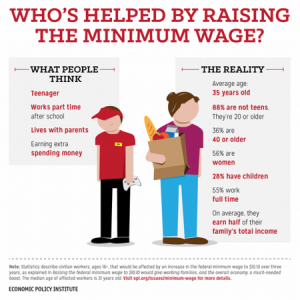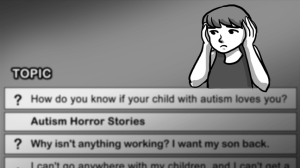
Source: WORT 89.9 fm
Most of us have had a shitty job or two.
Maybe it was a job that barely paid, where the managers acted like tyrants, and the hours were inconvenient and unforgiving. Maybe in high school, we had to work at the local Gap to save up for gas money or after college, we waited tables to pay off student debt.
But how many of us have actually had to support ourselves fully – let alone support a family – on a job like this?
There are a lot of people out there who have to do just that.
They earn the minimum wage at a thankless job that is their only form of income.
And that income is extremely low.
The federal minimum wage is $7.25/hour. That means $15,080 per year for a full-time worker.
Minimum wage varies depending on the state you live in, but most states have chosen to remain at the bottom of the wage scale.
Simply put, the minimum wage is too low and has been that way for far too long.
1. Why Is the Minimum Wage So Low?
In 2007, the federal minimum wage was raised for the first time after a full decade of stagnancy.
This increase was modest at best, and was completely incapable of measuring up to the intense increases in energy and food prices over that same ten years.
And since then?
The wage has remained fixed at this low rate.
Many workers employed at restaurants, nail salons, car washes, and other service jobs are even worse off.
Employers are allowed to legally pay these workers only the tipped minimum wage – a ridiculous sum of $2.13/hour. This wage has not been raised in twenty-two years.
Granted, the Fair Standards Labor Act (FSLA) mandates that if a worker’s total wages (tips plus the hourly $2.13) do not add up to the federal minimum, the employer must make up the difference.
But this is small consolation when all of the worker’s tip money has been used to close that gap.
2. Who Is a Typical Minimum Wage Worker?
The typical minimum wage worker is not who you’d think.
They are not, in fact, the stoner high school student looking to make extra cash or the aspiring post-grad working on their acting career.
They are the average low-income working adult, struggling to get by and provide for a family on a wage that is simply not high enough to pay for the expenses of modern day life.
In fact, 88% of minimum wage workers are over the age of 20, and astoundingly, more than one third are older than 40.
Sadder yet, these workers’ minimum wage salaries account for half of their total family income, on average. These are not side jobs used to earn vacation money. They are jobs that adult workers are trying to build their lives around.
Check out this infographic from the Economic Policy Institute for a visual portrayal of myths versus reality about minimum wage workers:
3. How Challenging Is it to “Make It” on the Minimum Wage?
Let’s take that average full-time minimum wage worker income of $15k/year and $7.25/hour and dissect it a little bit.
Living in the most expensive US state, Hawaii, you would have to work 175 hours per week to be able to afford a two-bedroom apartment on the minimum wage.
However, this a legitimate impossibility, as one week contains a total of only 168 hours.
Even in the much cheaper housing markets like Illinois – where the minimum wage is higher, at $8.25/hour, and the rents are lower – you’d have to work for a whopping 82 hours per week to be able to rent a two-bedroom.
So if you can’t house yourself, can you at least afford food?
According to the USDA, the cost of a healthy diet for a family of four ranges from $146-$289 per week. But even that lowest sum means buying the cheapest fruits and vegetables and doing considerable weekly planning as well as at-home preparation.
Many low-income working families do not have the luxury of free time to do these things.
And if both parents are working, who will take care of children? Daycare probably isn’t an option if you are living on a minimum wage salary.
Forget trying to raise a family, sending your kids to get an education with clothes that fit and supplies to do their homework. Forget living in a safe neighborhood with good schools. Forget fresh, healthy food.
Not to mention, minimum wage jobs almost never provide the necessary living wage benefits such as paid sick days, health care benefits, and retirement packages.
4. Make Minimum Wage? You Probably Need Welfare
For a minimum wage worker, it’s almost impossible to make it without relying on the assistance of federal programs.
When people use the age-old adage about how “lazy welfare recipients need to get a job,” they seem to forget the fact that many people who receive some form of government assistance are employed – but that the wages that they make are simply not sufficient to get by.
They are not “living wages.”
Huge corporations like Walmart and McDonald’s pay such low wages that their full-time workers live in poverty and are eligible to receive food assistance through SNAP, the program formerly known as food stamps.
What criticizers of welfare don’t (or pretend not to) realize is that the most effective way to reduce government spending on food stamps would be – you guessed it! – to raise the minimum wage.
If we want low-income people to work and be able to provide for themselves and their families without government assistance, we absolutely have to pay them a living wage.
5. Has the Minimum Wage Increased Appropriately Along with Inflation?
This is a simple answer: No.
In the year 1968, the minimum wage of $1.60/hour was substantial enough to lift a family of three out of poverty – even a family with only one income.
If the minimum wage had risen according to inflation over the years, it would be over $10 today.
And yet it remains stuck at a pitiful $7.25.
While the price of basic necessities like food and fuel has skyrocketed in recent years, minimum wage workers are trapped earning a wage that would have only been suitable decades ago.
6. Legislation on the Federal Minimum Wage
The Fair Minimum Wage Act of 2013 would raise the nationwide mandated wage to $10.10/hour by the year 2015, by way of three separate 95 cent increases. It would also increase the tipped minimum wage to 70% of the full rate.
Starting in 2016, the wage would also be “indexed” for inflation – meaning that it would rise according to how much the cost of living increases in the years to come.
The act would give 30 million workers a much-needed raise. Fifty-six percent of these are low-income women and almost half are workers of color. It would also mean a substantial income increase for the parents of over 17 million children.
Additionally, increasing the tipped federal minimum wage would mean a substantial step forward in women’s pay equity, as 71% of tipped wage workers are female. This makes raising the minimum wage a feminist issue as well as a labor and poverty issue.
In short, passing the Fair Minimum Wage Act would create a substantially better chance for working families to actually support themselves on a minimum wage salary.
7. How to Help Raise the Minimum Wage
If you think this is a good idea, you aren’t alone.
Recent polls show that two thirds of Americans support raising the minimum wage to $10 and indexing it so that it increases with the cost of living.
Call your elected officials in Congress and ask them to support the Fair Minimum Wage Act.
Join the email listservs and campaigns of pro-worker groups like the National Employment Law Project , NELP’s Raise the Minimum Wage campaign, the Economic Policy Institute or the National Women’s Law Center, who focus attention on raising the federal minimum wage and addressing pay inequity.
And get active on Twitter using the hashtag #RaisetheWage to spread awareness.
How Much Political Support for Exists for the Minimum Wage?
Slowly but surely, things are beginning to change – whether it be extending the minimum wage to those who do not currently have it or enacting higher state wages across the country – but there are still many who oppose a minimum wage raise with hellfire, claiming that there are “better ways to help the poor” because of the assertion that a raise will hurt small businesses, lead to further unemployment and cause economic downturn.
Economic studies show that these assumptions are wrong.
By a 4-to-1 margin, lead economists agree that raising the minimum wage does not reduce employment and that the economic benefit of doing so outweighs the cost.
Furthermore, more than two-thirds of small business owners support an increase of the minimum wage as well as indexing it for inflation.
In recent months, some strides forward have been made.
On September 17 of this year, the US Department of Labor announced the extension of overtime protections and minimum wage laws to home care workers.
After almost four decades of injustice, this monumental step will extend this crucial law to the two million American workers who care for the elderly and disabled in their homes. This measure is timely and much-needed, as home care assistance is one of the fastest-growing industries in our nation.
In another recent leap forward, the state of California is on track to pass the highest state minimum wage yet – $10/hour by the year 2016 (at present, the highest state wage can be found in Washington state at $9.19/hour). If enacted, this important increase is likely to lead the way for many other states to raise their minimum wages as well.
—
Raising the minimum wage will help boost the economy.
It will help families in need making a living wage and protect their children.
It will help people earn enough to not need government assistance to get by.
And it will help women and people of color.
To me, it’s a no-brainer.
Let’s #RaisetheWage – and let’s do it now. It’s been a long time coming.
[do_widget id=‘text-101′]
Danica Johnson is a Contributing Writer at Everyday Feminism and the Communications Manager at the Coalition on Human Needs, an alliance of national organizations working together to promote public policies addressing the needs of low-income and other vulnerable populations. Living in Washington, DC, this West Coast native uses her free time to write for her blog Duckyfem, practice yoga and spend as much time with animals and in nature as possible. Follow her on Twitter @duckyfem and read her articles here.
Search our 3000+ articles!
Read our articles about:
Our online racial justice training
Used by hundreds of universities, non-profits, and businesses.
Click to learn more
Most Read Articles
- « Previous
- 1
- …
- 30
- 31
- 32




















